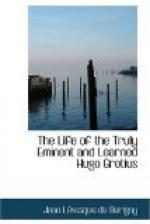FOOTNOTES:
[601] Rivet. Apol. discussio, p. 698.
XXII. In the examination of the other articles, which divide the Roman Catholics from the Protestants, Grotius continued to lean towards the Romish Church. In 1638 he acknowledges in a letter to Corvinus[602], that pious and able men, who were well disposed towards the Protestants, owned they were mistaken in the decision of the principal controversies between the Protestants and the Romish Church.
After the year 1640 he took no offence at the use of images in churches, and prayers for the dead. He writes to his brother this year[603], “The Lutherans have images, and there are some in several places of England. Montaigue and others have proved that it is not idolatry to have recourse to the prayers of the Apostles and Martyrs.”
He explains himself afterwards much more strongly in favour of the Romish Church. He was persuaded[604] that the Cherubims of Moses clearly shewed that images were not forbid. “The honour due to Martyrs, says he, in his Via ad pacem[605], is much greater than what we owe to living Saints, because the Apocalypse tells us, that the Martyrs reign with Jesus Christ: there is therefore no harm in publicly testifying our esteem for them, and celebrating their memories on days set apart for that purpose, and in the places where they suffered martyrdom. The Protestants acknowledge that they pray for the Church: they are in the wrong therefore to look on those as Idolaters; who, agreeable to the opinion of several ancients, think the knowledge of our wants and our prayers may be communicated to the Martyrs by a revelation from God, or by the ministry of Angels. Such, he says in another place[606], as think it idolatry to address, the Martyrs, that they may pray for us, accuse St. Chrysostom, and the other holy Doctors of the Greek and Latin Church, of a horrible crime. For my part, I dare not do this; neither would I blame those who abstain from praying to the Saints. I have also said that true Relics of true Martyrs deserve to be respected.”
In fine, in his Votum pro pace[607], he proves by a long series of passages from the Fathers, that the invocation of saints was used by the ancient Church, and therefore cannot be treated as idolatry; that there is no law in the Gospel against the use of Images in Churches, that it cannot be said they are forbid by the law of nature, and that in the times of St. Ambrose and St. Augustine the relics of Martyrs were honoured in the Church. He defends in several places Praying for the Dead, which was practised in all the Churches of the East, as well as of the West[608]: he proves that the ancient Church prayed for the Dead, and that St. Augustine[609] regarded the opposers of this practice as heretics. He maintains[610] that every ancient liturgy has prayers for the Dead, and that as Tertullian relates, they were used in all




